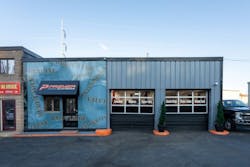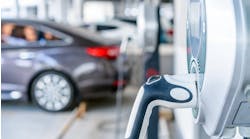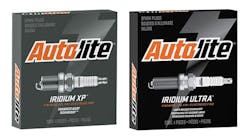Driving down West Boylston Street, it might be easy to miss Premier Auto Repair.
While the shop is set on a popular thoroughfare filled with name brand chains and local businesses, the two-bay Worcester, Mass., repair shop’s compact storefront is surrounded on both sides—nestled between the outposts of a local used car dealership.
“We hear it all the time,” says owner John Cayer. “Customers come in every week who never even realized we were here.”
Just the day before, a regular at the Dunkin’ Donuts only 200 feet away dropped in for the first time, stunned at his discovery after driving by what must have been hundreds of times. “With less than 1,000 square feet, it can seem like we’re hidden in plain sight.”
While many may think small shops are a dying breed with limited potential and a grim future, Cayer hasn’t let the shop’s size hold him back. With a team of four bringing in nearly $800,000 in annual revenue on just two bays, he’s one of many notable independent operations proving a unique strength in numbers—churning out impressive results despite small shop footprints or staff sizes.
To learn what it takes to stand out and succeed as a small operation, Ratchet+Wrench spoke with Cayer and the owners of other small but mighty shops to see how they’re harnessing their space, manpower, and resources to build lean and nimble operations for maximum output.
SHOP STATS: Premier Auto Repair Location: Worcester, Mass. Operator: John Cayer Average Monthly Car Count: 150 Staff Size: 4 Shop Size: ~950 square feet Number of lifts: 2 Annual Revenue: $795,000
Make It Work
When Cayer overheard a customer say Premier Auto Repair’s lobby reminded them of sitting in a closet, he knew it was time for a redesign.
Not only did customers often confuse the shop with the used car dealership that occupies storefronts on either side (even leaving negative Google reviews based on experiences at the dealership on Premier Auto’s account), the shop lacked a front counter and dedicated space for a service advisor.
“We had been making it work and bringing in business, but it was time to convey our professionalism and the quality we produce,” Cayer says.
“Working in a small shop is all about learning to innovate within the box and be resourceful with the space you have.”
Just weeks after the redesign, new customers began streaming in, all wondering if the shop was part of a new chain. With a new polished look, Cayer says he’s been able to attract more of his ideal customers and increase his rates.
“This wasn’t a full remodel and it didn’t replace our core marketing efforts, but it did help us build our own value and trust from our customers that’s paying off in the bottom line,” says Cayer.
Design for Maximum impact
With extremely limited space, Cayer got crafty in finding ways to make the most of the shop’s every square inch in the shop’s redesign.
Drawing from previous experience working in construction with his father, Cayer drafted precise layout options to pinpoint a clear vision before work began.
By bringing the lobby’s ceiling up from 90 inches to nealy 14 feet, and adding windows and a sliding glass door between the reception area and shop floor, Cayer was able to give the illusion of more space. Customers can now see repairs in action through the windows and the higher ceilings have made the lobby feel much larger without having to physically dedicate much additional floor space.
The shop’s work floor was also reorganized and 30 square feet where the shop’s oil barrels took up space were repurposed. Two 300-gallon oil tanks are now stored vertically with reels mounted to the ceiling (a solution usually seen in much larger shops). Cayer also moved oxygen and acetylene tanks to the compressor room, adding retractable reels for easy access.
Cayer also updated the shop’s logo, incorporated a grey and orange color scheme to the shop’s exterior design, and tweaked the name from “Premier Automotive” to “Premier Auto Repair” to more clearly differentiate the shop from its neighbor.
Always Be Moving
With just two bays, two service advisors, and a focus on tracking gross profit by the hour, Cayer’s core strategy for keeping car count and efficiency high is to keep things moving.
When Cayer and his team run into a 20-minute part delivery wait, they take the car off the lift and put another on.
“It takes 45 seconds to a minute to get a new car on the track, whereas waiting for that part is going to cost us 20,” he says.
Larger shops may balk at the idea of pulling a car in three times to finish a repair, but Cayer says that flexibility is critical.
“We make sure not to have more than one vehicle that can’t be put back together in 10 minutes at any given time because it shuts you off to anything coming in,” he says. “There’s no flexibility. You’re committed.”
The Premier team also calls about each parts order (even online orders) for real-time delivery updates, schedules waiters before noon, and encourages drop-offs and the use of the shop’s loaner cars so they have more control over shuffling jobs around.
“One of our biggest priorities is the ability and willingness to pivot at any given moment to be able to change on the fly and foresee what’s coming next,” says Cayer. “It’s something I’m trying to teach my service advisor and it only comes through practice.”
Cayer says this ability is particularly critical in a small shop like his where there are fewer resources to lean on.
“If we had another bay or a bigger staff, we might have more leeway, but if you end up down a tech or order the wrong part for a repair and you don’t understand how to rearrange, you can throw off days of work,” he says.
SHOP STATS: My Mechanic Maintenance & Repair. Location: Tucson, Ariz. Operator: Dena and Billy Ganje Average Monthly Car Count: 200 Staff Size: 6 Number of lifts: 6 Annual Revenue: $1.2 million
More than Meets the Eye
“I’ll be honest, we’re not much to look at,” says Dena Ganje, co-owner and business coordinator for My Mechanic Maintenance & Repair in Tucson, Ariz.
Set yards back from the road, the shop’s tiny, squat garage face begins to blend with its industrial surroundings in a nondescript business park filled with fabrication shops and public storage facilities.
“We’re located in an unsightly, rundown, working class part of town,” she says, frankly. “But we’re busy around the clock.”
From Monday through Friday, the shop’s front lot is a constant flurry of motion as customers arrive and depart while the shop’s team expertly navigates the organized chaos. But how and why?
“It’s all about word-of-mouth and our reviews,” she says. “Customers drive from all over because they heard great things from a friend or looked us up online and couldn’t pass us up, and that really comes from our transparency.”
Seize the Moment
As customers enter the 500-square-foot front office, they become a part of the shop’s hustle and bustle as the team answers phones and shares repair updates with the rest of the team.
“They’re seeing and hearing us speak openly and freely about what’s going on, including with their vehicle. There’s no one behind the scenes. They’re getting to be included in the action,” says Ganje.
It’s why the team firmly doesn’t provide prices over the phone, too—Ganje wants the customers to come in and experience the shop, quelling any doubts about the shop’s appearance or location.
The team spends time on answering questions and educating customers and, if a customer expresses gratitude, Ganje doesn’t demure.
“When someone says, “I’m so glad I found you,’ that’s when we seize the moment and ask if they’ll pass it on either in person or online,” she says. “I wouldn’t say you need to be your own shameless marketer, but it’s creating customer advocates and if they meant it they’ll follow through.”
With word-of-mouth success, the lobby has become a testament to the shop’s referral community as a site where friends and referrals bump into one another as they pick up their cars.
Synchronized & Streamlined
With no marked parking and shop equipment spread across multiple buildings, the My Mechanic team has devised a fine-tuned process for workflow.
Creating a pseudo valet service, customers pull up to the front of the shop and a team member drives the car to the appropriate space. The same occurs upon delivery.
“The team has this system perfectly choreographed,” says Billy. “We’ll talk to the customer as they’re getting checked out and as soon as they turn around, suddenly their car is there and it’s on and ready and pointed in the right direction with the A/C running—it sounds small but it’s saved us and the customers so much frustration and confusion, and it makes them feel like a VIP.”
Building relationships with neighbors has also proved beneficial, as the shop has slowly grown its footprint with the rental of space in the surrounding parking lots.
The shop’s front lot is utilized for quick, short-term repairs, while long-term or heavy line projects that have yet to be diagnosed or are awaiting approval are left in the back lots.
A workflow board, detailing services required, vehicle owner, parking location, and repair stage, is also updated by the entire team multiple times per day.
Eager to Invest
As a small operation, the shop was happy to reduce its equipment investments by sending some jobs to neighboring shops—until customers started to complain.
“We’d hear from clients who were disappointed that their experience with our recommendations didn’t match their experience with us,” says Ganje. “Eventually we realized we could better serve our clients if we made the effort to invest in ourselves.”
To afford the required investments—tire, A/C, and additional programming equipment, as well as a Hunter alignment rack—the Ganjes met with other local shops in the area to form partnerships. Those shops send alignments and other repairs they’re unable to complete to My Mechanic.
With each investment made, the Ganjes diligently track ROI. For example, after finding the shop’s free shuttle service was insufficient, the Ganjes invested in five loaner cars, which only took one month to begin paying for itself (despite purchase price, maintenance and insurance costs).
“It’s trackable.That’s the kind of investment that takes a shop from small to mighty,” she says.
SHOP STATS: Stack's Auto Service & Tires Location: North Babylon, N.Y. Operator: Tom Cummings Average Monthly Car Count: 350 Shop Size: 1,500 square feet Staff Size: 6 Number of lifts: 3 Annual Revenue: $1.8 million
Determined to Exceed Expectations
When Tom Cummings bought Stack’s Auto Service & Tires in North Babylon, N.Y. in 2004, he knew he had his work cut out for him.
The shop’s original owner and namesake had run a decent shop, but was a gruff man.
“He was the original [Seinfeld] Soup Nazi,” said Cummings. “He could be nasty and he made a lot of customers uncomfortable. They just didn’t want to come in to deal with him.”
After buying the 1,500-square-foot shop, Cummings immediately threw his efforts into marketing, putting his picture in the local paper, and building a strong team with a relaxed family dynamic to show the shop had started a new chapter.
“Suddenly people were talking,” he says. “It was amazing how customers turned up little by little, when they realized the atmosphere had completely changed. It was like the shop had a whole new aura and we took off.”
Plan for change
While the shop’s friendly team and relaxed atmosphere keep loyal customers coming back, Cummings continues to rely on his marketing efforts to bring in new customers, finding the most success with direct mail. Based on Long Island in a residential area, Cummings says direct mail helps combat one of his biggest challenges in customer retention—New York’s cost of living.
The shop is surrounded by apartment buildings, “which is great for bringing in new customers, but once they leave, we rarely see them come back. They’ve usually moved to another state.”
Cummings notes the challenge keeps his team sharp and pushes them to stay on top of their marketing efforts.
“When we tweak our strategy or a mailer doesn’t get out, we’re seeing the benefits or consequences pretty quickly,” he says. “It’s a constant reminder to stay on our A-game."
Maximize manpower
When it comes to workflow, Cummings—now known as “The King of Three Bays”—has a clear strategy.
“A lot of big operators will have multiple lifts for each tech so they can leave a car on a lift. We’ll pull a car on, check it, write it up, pull it off, pull a new one on and repeat,” Cummings says. “That’s what makes us efficient with our limited space, so we can be quick, accurate, and tee things up strategically based on which tech is fastest at a certain repair.”
Cummings recently hired a general service staff member and invested in an outdoor scissor lift. His general service tech spends most of his day coordinating and completing customer pick-ups and drop-offs, managing the loaner cars, picking up tire shipments, and servicing flat tires or minor repairs on the outdoor lift in between.
“That’s normally something a smaller shop wouldn’t have, but my feeling is, why not keep our most skilled manpower where we need it most and squeeze more capacity out of a space we weren’t using?” he says. “Having that ability to address volume and utilize the entire facility is critical when you’re as small as us.”
Mindset Over Matter
While Cummings is quick to celebrate his team for the shop’s impressive output, there have been a few guiding principles he’s come to rely on.
Before buying Stack’s, Cummings says he always hoped to have a shop where the team took such responsibility and initiative, that it wasn’t apparent who the owner even was.
“We’re getting to the point where new customers have no idea who I am and they’re fully developing strategies and checklists without me,” he says. “It’s amazing to see.”
Cummings has also learned to keep business moving with a swift decision-making process, which wasn’t always easy for him. Today, he’ll meet with his managers, talk through an idea for a day or two, then pull the trigger.
Whether exploring alternatives to his digital vehicle inspection system or considering marketing tweaks, Cummings has found that, “the faster you fail, the better off you are and the less recovery time you have to make up for. Wading in and dragging your feet can kill you slowly by losing months or years to a bad plan before you realize it’s too late.”
He sets goals just out of reach to keep operations focused and his team motivated to push for the best.
“I know people have some set ideas on what you can do in a small shop, but I love to prove them wrong,” he says. “The more I hear, ‘you’ll never be able to do that in a three-bay shop,’ it lights a fire and drives us to push even harder.”




